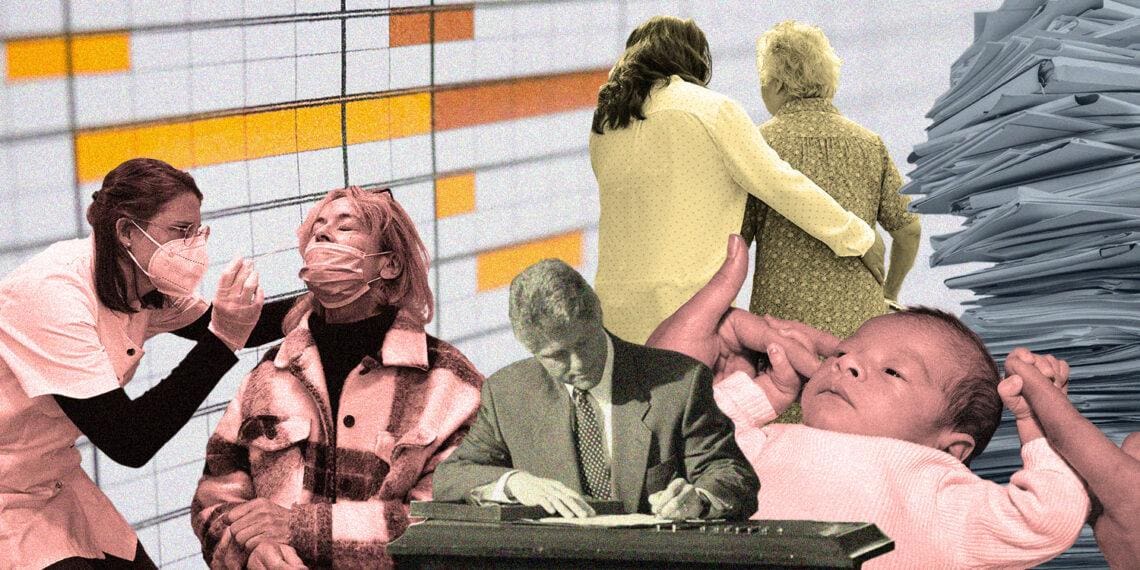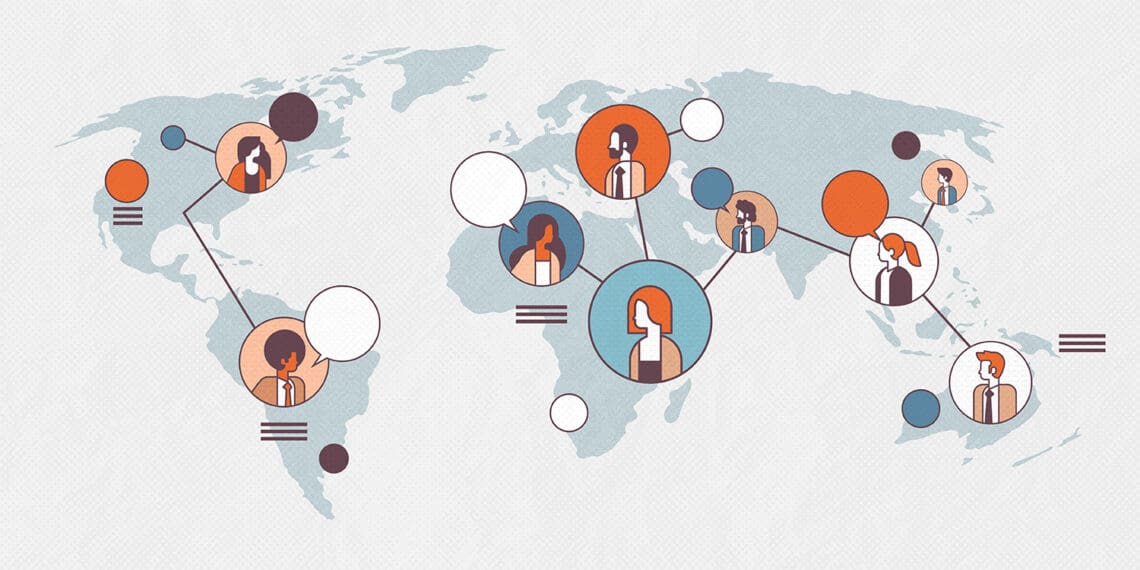The Family and Medical Leave Act turned 30 years old this month, and while the law protects (some) workers’ jobs, it also comes with a host of hoops to jump through, both for businesses and for workers. Compliance and legal experts weigh in on what works about FMLA — and what should change.
“The need for this legislation is clear. The American workforce has changed dramatically in recent years. These changes have created a substantial and growing need for family and medical leave for working Americans.” — This is what President Bill Clinton said when he signed the Family and Medical Leave Act into law in February 1993.
In the intervening three decades, has much changed? To be sure, millions of workers have used FMLA protections to ensure that they can return to their jobs after having a child or taking intermittent leave to care for an aging parent.
But today’s workforce is changing, too. An estimated 59 million people made money from gig work in 2022, according to a study by Legal and General, and that number is expected to surge to nearly 86 million by 2027. Further, most of these workers are unlikely to return to traditional employment, with 69% saying they intend to continue their current work.
And while the headlines aren’t as dire today as they were three years ago, millions of Americans have either gotten sick from Covid-19 or had to stay home to care for an ailing family member, while still others are dealing with long Covid. A CDC study found that about 15% of all U.S. adults have had long Covid, meaning effects that lasted three months or longer, and according to a Brookings Institution analysis, as many as 4 million people are out of work because of long Covid.
America’s changing workforce and the ongoing Covid-19 pandemic have laid bare the shortcomings of relying on a federal law that doesn’t even guarantee paid leave — and doesn’t cover tens of millions of workers in the first place.
Given those factors, would businesses and workers be better off if lawmakers retooled FMLA or replaced it altogether?
What does FMLA guarantee?
While FMLA was designed to require employers to provide family and medical leave, there are significant exceptions that exclude a huge swath of the American workforce. For example, companies with fewer than 50 employees are not obligated by FMLA to guarantee leave, workers only become eligible if they put in at least 1,250 hours in a 12-month period, and it applies only to people who work in a location where their company employs at least 50 people in a 75-mile radius.
That leaves 44% of Americans on the outside looking in — 21% don’t work enough hours and another 15% work for non-covered employers, according to the most recent estimates. Women are less likely to be covered by FMLA, as are low-wage workers, only 38% of whom are eligible.
Still, despite the fact that millions of workers aren’t covered, for employers whose businesses are required to guarantee FMLA, most see it as a positive mandate, said Michelle W. Johnson, a partner and employment lawyer in the Atlanta office of Nelson Mullins.
“For employers, FMLA provides a framework to provide leave to employees and helps everyone to know the rules,” she said. “For example, knowing that employees are entitled to 12 weeks for pregnancy/childbirth takes away pressure on employers to provide more or less time off. If employers provide more time, they are perceived as being generous since they are exceeding what the law requires. However, the framework of 12 weeks also evens the playing field since the baseline is the same of all covered employers.”
With Employees on the Move, Make Sure You Can See the Entire Map
About two-thirds of American employees work remotely at least part of the time. Ensuring compliance means more than just making sure they log on at the right time. Tax expert Jennifer Stein talks about the importance of aligning all your organization’s stakeholders to reduce risk.
Read moreDetailsIn addition to providing a competitive advantage for companies that can be more generous with their time-off packages is that the nature of the FMLA process opens an employer-employee dialogue, said Angella Myers, co-chair of Kaufman Dolowich & Voluck’s labor and employment group.
“The biggest strength, I think, for workers and employers is that it opens the discussion. When an employee knows they have to be out, that’s where it’s especially helpful,” Myers said. “The easiest one is pregnancy or expectation of a child coming into the home. That’s the easiest because you usually know that in advance. You have time to have the discussion about it and it just opens the door and lets the worker come in and express the time they’d want off, and so it’s an interactive discussion, which is great. The employer has time to plan ahead to meet its needs, the employee has time to plan ahead to know what’s expected.”
While FMLA does not mandate employers provide paid leave, many allow workers to take paid time off in conjunction with FMLA provided they have the sick time or PTO hours, but the unpaid nature of FMLA is perhaps the biggest drawback for workers.
After all, what good is 12 hours of time off if you can’t pay the bills? While there’s broad public agreement that employers should be required to offer paid family and medical leave (85% according to a Pew survey), that has not yet translated to a legislative mandate. A provision of the Build Back Better package would have created a universal paid family and medical leave program and while the House of Representatives narrowly passed it, the provision did not survive the U.S. Senate.
Eleven states and the District of Columbia do have laws mandating certain employers offer paid family and medical leave, funded through a combination of employee- and employer-paid taxes, and 16 states require paid sick leave. Still, according to the most recent data from the Bureau of Labor Statistics, the average U.S. worker has only seven days of sick leave and between 11 and 20 vacation days, far fewer than the 12 weeks of unpaid leave FMLA guarantees.
The burden on business
FMLA is a complex law with many rules and qualifications, and the burden is on businesses to ensure they’re providing the benefits to which their employees are entitled. But most companies appreciate the predictability of the law itself, provided they have someone on staff who understands their obligations.
“I often describe FMLA as another kind of ‘grand bargain.’ An eligible employee who needs time away from for a qualifying reason gets the time she needs, with the peace of mind that she won’t lose her job,” said Heather Hammond, an HR and employment attorney at Gravel & Shea in Burlington, Vermont. “Employers, on the other hand, generally like the certainty of a set of rules and regulations upon which they can rely and plan.
And the unpaid nature of the leave means it doesn’t really cost a business extra money to hold someone’s job open while they bond with their newborn baby.
Of course, not all FMLA claims are parental or even predictable, and compliance experts generally agreed that intermittent leave was one of the biggest burdens for businesses under the current FMLA model. Myers offered the example of an adult child whose parent has been diagnosed with cancer and needs rides to chemotherapy or radiation treatments but also needs someone to sit with them the remainder of the day or even the next day if the treatments are particularly taxing.
Such uneven time off can be a challenge for businesses to manage, and the smaller the business, the tougher it will be to balance time off with the needs of serving customers and clients. In those cases, Myers again points to collaboration between employer and employee.
“Let’s say you’re an attorney and you’re a trial attorney. And so when a judge calls you to trial, you need to be there. So during that scenario, perhaps you’re not a trial attorney for a while; you hand your trial cases to somebody else because your schedule will not let you just be there when the judge wants you to be there. So you can do other things within the law firm instead of trial work, things that would allow you that flexibility.”
The patchwork of state and local laws doesn’t help either, said Reed Smith partner Amanda E. Brown, who said the overlap between federal and other regulations is challenging and often confusing for employers, as is the potential for overlap between FMLA and similar laws like the Americans with Disabilities Act.
And in a competitive job market, FMLA allows employers to retain skilled workers, which Crowell & Moring’s Christine B. Hawes sees as another of the big benefits to employers.
“Employers can have more certainty that a trained employee is more likely to return after a leave of absence, rather than having to find a permanent replacement,” Hawes said.
In her work, Myers sees companies making good-faith efforts to provide FMLA-covered leave rather than bristling under the weight of the compliance burden FMLA creates: “Every day, all day, I see employers wanting to do the right thing, asking questions about, ‘Is this right? Is this how I do this?” They call me not trying to avoid [complying]; they call me making sure that they are.”
Covid side effects
The unpaid and uneven nature of FMLA was on full display during the pandemic, as millions of people who got sick or had loved ones who got sick were not covered, and while a federal law expanded paid leave for some Covid-related reasons, the requirement expired in 2020.
“Being sick from Covid generally is not covered by FMLA, unless the employee sought medical treatment in conformance with the FMLA rules,” Hammond said. “Similarly, FMLA’s ‘caregiver’ leave didn’t really fit scenarios where people needed to stay home and care for loved ones with Covid. And certainly the quarantine requirements were not covered by the law.”
While the Families First Coronavirus Response Act did attempt to address the situation, albeit temporarily, in many situations, people who should have been able to stay home and not worry about losing their job couldn’t. For example, uninfected people who were ordered to quarantine generally were not afforded FMLA protections. And as new Covid waves rise, this issue is likely to come up again, Hawes said.
“Now we know that other types of public emergencies may leave employees unable to go to work, unprotected by FMLA, and leave employers without guidance about how to proceed,” she said.
In Myers’ job, which consists mostly of advising companies on FMLA matters, the pandemic led to an enormous upswing in her workload: “We were pretty much a 24/7 shop during Covid,” Myers said. “Especially depending on what you did. If you were a company that could shut down, if you were a hospital or you needed to work, you needed your employees there to help take care of your patients.”
And though the Biden Administration plans to allow the pandemic emergency declaration to expire this year, Myers and her firm are still seeing the FMLA-related impact of the virus.
“We really are seeing people who want to get back to work, but their bodies aren’t allowing them to do what they used to do. And there’s a difference, too, between jobs that are sedentary and jobs that are very physical. To get back to those jobs is a challenge and we definitely are seeing people who had Covid and … they’re now negative if you test them. But they will tell you, and their bodies will tell you, that it’s not the same as it was before.”
What would an FMLA replacement look like?
Mostly, compliance experts agree that FMLA provides a solid set of protections for both employers and employees, and generally, they told us it would be an ideal model for a future national paid-leave law. That’s not to say they don’t have ideas about how to make it better.
For one, a federal paid leave law would set a national standard and reduce friction with state and local laws, Hawes said.
“One of the biggest compliance hurdles for employers is the potential overlap and conflicts between the FMLA and other federal, state and local laws that provide for paid and unpaid leave. This includes the patchwork of state and local laws providing for mandatory paid sick leave and paid family or medical leave,” she said. “This is particularly true for employers with multi-state operations and those with remote workforces with employees working from home scattered across the country. A federal law that would create uniform requirements and allow employers that are compliant with the federal standard to be exempt from other conflicting state and local laws might resolve much of this difficulty.”
While Brown sees a national law as a nod toward providing clarity, if it comes at a much higher cost, it might not be worth it.
“In an ideal world, employers would not have to navigate complying with local paid sick leave laws on top of FMLA, but that raises a lot of difficult questions about the cost to employers of a [federal law],” Brown said. “The identification of the need for leave and certification/designation requirements for employers may be a trap for the unwary employer who is not proactively analyzing employees’ need for leave.”
The feds could also help businesses out by providing additional guidance on the use of intermittent leave, she said.
As for elements of FMLA to revisit and consider revising, Myers has what she thinks might be an unpopular opinion: rethink the 1,250-hour minimum.
“You literally have to sit there and count up the hours sometimes. And sometimes people can’t make the hours through no fault of their own. Like Covid; you were shut down for Covid. Nobody was working 1,250 hours at lots of places. I understand putting a time commitment in there. So an employee is with this employer for a certain amount of time. I get it, but I think the 1,250 hours and 12 months can be duplicative a lot of times. I mean, hopefully, if you work somewhere 12 months, you’ve worked 1,250 hours. So I think replacing that with something that’s an easier metric that could be more across-the-board would be easier to apply.”
A Bipartisan Policy Group analysis in 2022 found that reducing the hours requirement to 780 would cover an additional 3.4 million workers, while reducing the worksite size requirement from 50 to 30 would add another 3.2 million. However, all the employment experts we talked to agreed that small businesses can be much more acutely affected by workers taking leave.
“Small employers, such as those with fewer than 50 employees within a 75-mile area, would often find it difficult or impossible to comply with a program requiring them to provide 12 or more weeks of leave and continue normal business operations,” Hammond said.




 Jennifer L. Gaskin is editorial director of Corporate Compliance Insights. A newsroom-forged journalist, she began her career in community newspapers. Her first assignment was covering a county council meeting where the main agenda item was whether the clerk's office needed a new printer (it did). Starting with her early days at small local papers, Jennifer has worked as a reporter, photographer, copy editor, page designer, manager and more. She joined the staff of Corporate Compliance Insights in 2021.
Jennifer L. Gaskin is editorial director of Corporate Compliance Insights. A newsroom-forged journalist, she began her career in community newspapers. Her first assignment was covering a county council meeting where the main agenda item was whether the clerk's office needed a new printer (it did). Starting with her early days at small local papers, Jennifer has worked as a reporter, photographer, copy editor, page designer, manager and more. She joined the staff of Corporate Compliance Insights in 2021. 








